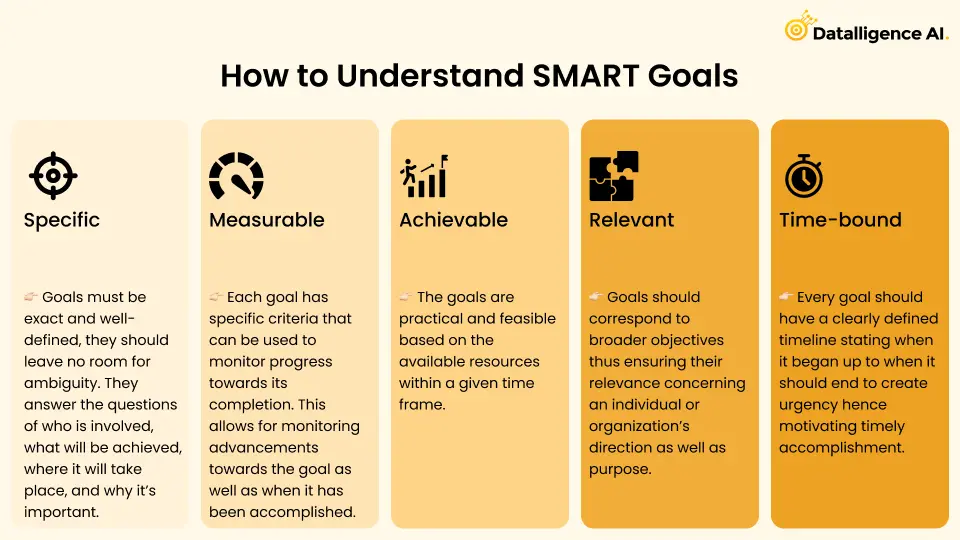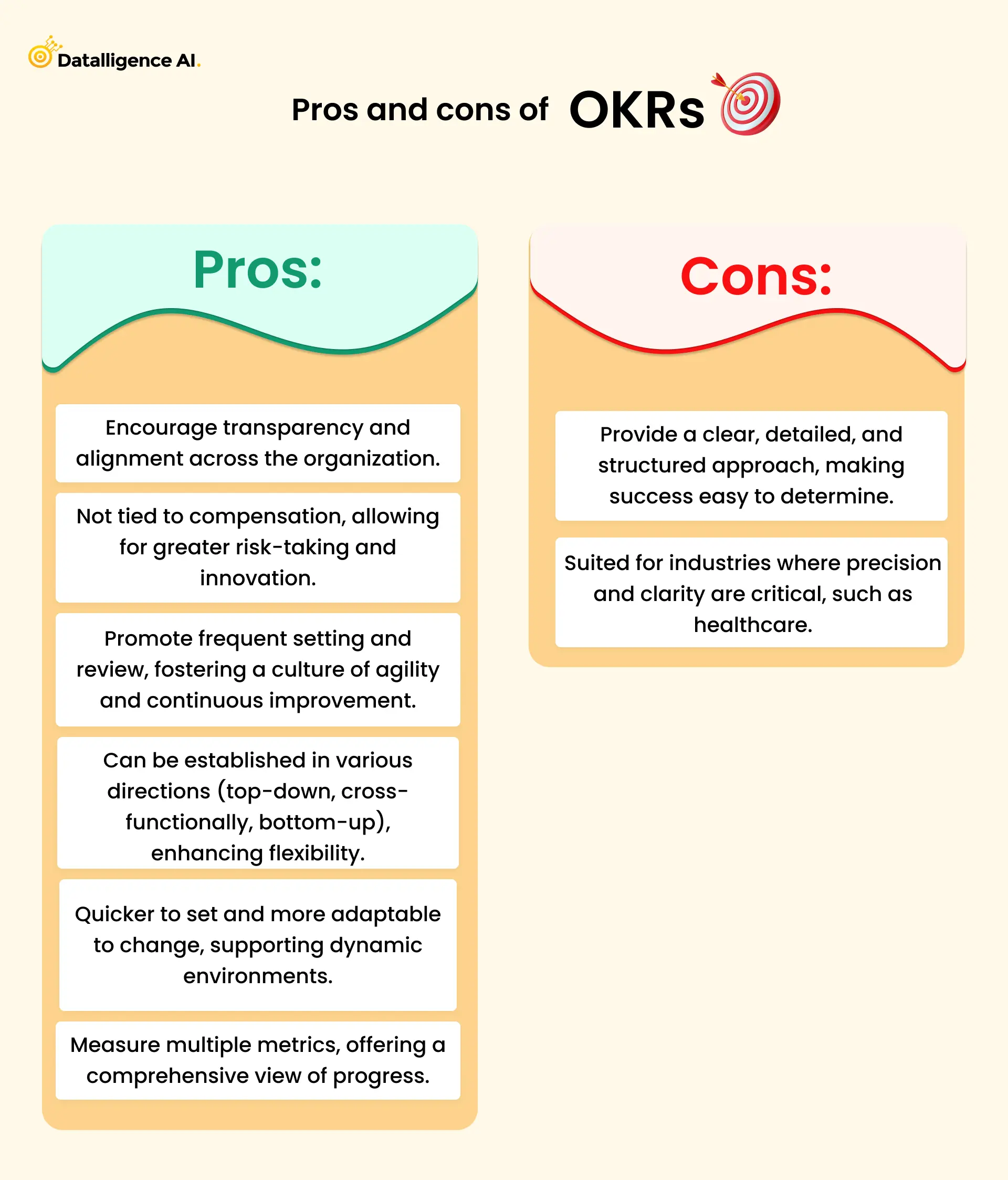In the landscape of organisational development, SMART goals for agile transformation offer a structured way of setting objectives that are specific, measurable, achievable, relevant, and time-based. This acronym not only captures a method for creating practical goals but also connects well with the principles of agile transformation—a process characterised by small iterative changes that aim at making lasting improvements. Nevertheless, as industries transform over time, limitations associated with smart goals, particularly about employee engagement, call for more flexible frameworks.
FAST Goals, an alternative to SMART, focuses on regularity, bigness, clarity, and openness of objectives, reflecting the soul of agility in its emphasis on being simple and fast. This approach, along with the common OKR (Objectives and Key Results) framework, serves as the basis for agile transformation—changing organisational behaviour, beliefs, and culture while driving toward the adoption of disruptive technologies. To move away from conventional ways of doing things, it is important to understand how SMART goals can be merged with FAST ones to achieve the best performance results; hence showing how agile transformation can be achieved.
What are SMART goals?
SMART goals, which stand for Specific, Measurable, Achievable, Relevant, and Time-bound, are used in personal and professional settings to set clear and reachable objectives. The structure of SMART goals is such that every goal forms:

By adhering to these criteria, SMART goals provide a structured approach to goal setting that enhances clarity, focus, and the achievability of objectives, making them a pivotal tool in the arsenal of project management and personal development strategies. This structured methodology not only facilitates effective planning and execution but also promotes accountability and measurable success in achieving targeted outcomes.
OKR and SMART goals
Integrating OKRs (objectives and key results) with SMART goals provides a robust framework for agile organisations aiming for continuous improvement and agility. This combination leverages the strengths of both methodologies to foster an environment where ambitious goals align with specific, measurable actions. Here’s a closer look at how these frameworks interact and complement each other in an agile transformation context:
- Alignment and Flexibility:
- OKRs focus on aligning teams and departments towards common, ambitious objectives, fostering organisational unity and direction. They are adaptable, allowing adjustments in response to changing circumstances.
- SMART Goals emphasise setting individual goals with clear timelines, ensuring accountability and clarity in execution. Their specificity and measurability align well with the key results aspect of OKRs.
- Application Levels:
- OKRs are set at company, team, and individual levels, promoting a holistic approach to goal-setting that encourages broad participation and buy-in.
- SMART Goals are typically individual-focused but can be elevated to team or organisational objectives when integrated with OKRs, enhancing their utility and scope.
- Combining for Enhanced Outcomes:
- The concept of SMART OKRs emerges as a powerful tool, applying SMART criteria to OKRs to create objectives that are not only ambitious and aligned but also specific, measurable, and time-bound. This hybrid approach maximises the strengths of both frameworks, making it suitable for dynamic industries or organisations seeking transformative change.
By thoughtfully integrating OKRs with SMART goals, agile organisations can achieve a balance between aspirational objectives and practical, actionable plans, driving meaningful progress and fostering a culture of continuous improvement.
Pros and cons of OKRs and SMART goals
Pros and Cons of OKRs and SMART Goals


This comparison highlights the distinct approaches of OKRs and SMART goals towards goal setting, with OKRs leaning towards flexibility and adaptability, and SMART goals emphasising specificity and measurability.
Are OKRs better than SMART goals?
Determining whether OKRs or SMART goals are more advantageous hinges on the specific objectives and context of an organisation. Here’s a concise comparison to guide decision-making:
- Objective Scope and Scale:
- OKRs: Best suited for ambitious, large-scale, long-term objectives. They are designed to push organisations towards substantial achievements by focusing on big-picture aims.
- SMART Goals: More appropriate for individual, short-term, or one-off goals. Their structured framework targets efforts toward achieving specific, measurable outcomes within a defined timeframe.
- Metrics and Measurement:
- OKRs: Effective for multi-metric goals, allowing organisations to track and measure progress across various dimensions and scales.
- SMART Goals: Tailored for single-metric targets, providing clear, quantifiable measures of success or failure.
This comparison underscores that the choice between OKRs and SMART goals should be aligned with the nature of the objectives at hand. OKRs excel in driving large-scale, strategic initiatives, whereas SMART goals offer precision and clarity for more immediate, tangible targets.
Disadvantages of SMART Goals
While SMART goals have been lauded for their structured approach to achieving objectives, they are not without their limitations, especially when applied within dynamic and complex environments. These disadvantages can significantly impact their effectiveness, particularly in agile transformation efforts where flexibility and continuous learning are paramount.
- Adaptability and external factors:
- SMART goals may not sufficiently accommodate external changes such as market dynamics or unexpected challenges, leading to rigidity.
- The framework often lacks the flexibility for mid-course reassessment, which is critical in scenarios like a pandemic or shifting organisational priorities.
- Motivation and Growth:
- Setting goals that are too easily achievable might not push individuals or teams to their full potential, potentially acting as a ceiling rather than a growth platform.
- The focus on specific, measurable outcomes can sometimes overshadow the importance of process-oriented goals, relationship-building, or the acquisition of new skills, which are crucial for personal development and organisational innovation.
- Creativity and Strategic Planning:
- A narrow focus on achieving specific targets can inadvertently inhibit creativity and discourage bold, strategic actions that could lead to significant advancements.
- The emphasis on short-term objectives might lead to a neglect of long-term strategic planning, essential for sustained success in rapidly evolving markets.
These aspects highlight the need for a more flexible and encompassing approach to goal setting within agile environments, where the pace of change and the importance of continuous learning and adaptation cannot be overstated.
Are OKRs better than SMART goals?
Determining whether OKRs or SMART goals are more advantageous hinges on the specific objectives and context of an organisation. Here’s a concise comparison to guide decision-making:
- Objective Scope and Scale:
- OKRs: Best suited for ambitious, large-scale, long-term objectives. They are designed to push organisations towards substantial achievements by focusing on big-picture aims.
- SMART Goals: More appropriate for individual, short-term, or one-off goals. Their structured framework targets efforts toward achieving specific, measurable outcomes within a defined timeframe.
- Metrics and Measurement:
- OKRs: Effective for multi-metric goals, allowing organisations to track and measure progress across various dimensions and scales.
- SMART Goals: Tailored for single-metric targets, providing clear, quantifiable measures of success or failure.
This comparison underscores that the choice between OKRs and SMART goals should be aligned with the nature of the objectives at hand. OKRs excel in driving large-scale, strategic initiatives, whereas SMART goals offer precision and clarity for more immediate, tangible targets.
What are FAST goals?
FAST goals, emerging as a dynamic counterpart to the established SMART framework, offer a fresh perspective on achieving organisational success, particularly in agile environments. They are defined by four core principles:
Frequent Communication: FAST goals prioritise continuous dialogue around objectives, ensuring they remain at the forefront of team efforts. This frequent engagement facilitates agility in response to changes, fostering adaptability—a critical advantage over the more static nature of SMART goals.
Ambition: They encourage setting high-reaching targets, pushing teams to extend beyond their current capabilities. This ambition is balanced with realism to maintain motivation and drive substantial progress, contrasting with SMART goals’ potential for setting too comfortable targets.
Specificity and Transparency: Similar to the specificity in SMART goals, FAST goals also demand clarity in expectations. However, they emphasise transparency, ensuring that goals and progress are openly shared and understood across the organisation. This clarity supports alignment and collective effort toward common objectives.
The strategic use of FAST goals, particularly in conjunction with OKRs (objectives and key results), enables a holistic approach to goal setting and achievement. OKRs complement FAST by outlining critical objectives linked to measurable results, enhancing focus on outcomes rather than just outputs. Together, they form a comprehensive framework that supports strategic alignment, fosters transparency and accountability, and enhances execution. This alignment is crucial for organisations aiming for significant growth or navigating rapid changes, where the combination of long-term vision and short-term agility is essential.
OKR and FAST Goals
Integrating FAST goals with OKRs (objectives and key results) creates a robust framework that propels organisations towards overachievement and maintains agility. Here’s how they complement each other:
- Transparency and Teamwork vs. Alignment and Self-Motivation:
- FAST goals promote organisational transparency and foster a culture of teamwork by ensuring goals and progress are openly shared.
- OKRs focus on alignment across the organisation and bolster self-motivation by linking individual contributions to the company’s broader objectives.
- Synergistic Effects:
- Combining FAST goals’ emphasis on continuous discussion and review with OKRs’ structured approach to goal-setting enhances the organisation’s ability to adapt and overachieve.
- This integration ensures that ambitious goals are not only set but also continuously monitored and adjusted transparently, aligning short-term actions with long-term strategic visions.
- Transparency and Teamwork vs. Alignment and Self-Motivation:
- OKRs operate every quarter, offering four opportunities each year for teams to assess and improve their results, fostering a culture of continuous learning and improvement.
- When paired with the dynamic nature of FAST goals, this cyclical approach enables organisations to rapidly adapt to changes, ensuring sustained growth and innovation.
Conclusion
Throughout our exploration of the SMART and FAST goal-setting frameworks in the realm of agile transformation, it has become clear that each approach offers unique advantages that, when strategically integrated, forge a path toward maximising organisational efficiency and innovation. The SMART framework, with its emphasis on specificity, measurability, achievability, relevance, and time-bound objectives, provides a solid foundation for goal-setting by ensuring clarity and focus. Conversely, the FAST methodology advocates for flexibility, ambition, specificity, and transparency, and fosters a dynamic environment conducive to rapid adaptation and continuous improvement, closely aligning with the agile principles that drive today’s leading organisations towards success.
In conclusion, the merger of SMART and FAST goals underscores the essence of effective agile transformation – a balanced approach that leverages the structured precision of SMART goals with the agility and speed of FAST objectives. This hybrid strategy not only enhances operational outcomes but also propels organisations toward realising their long-term strategic visions while being fully equipped to navigate the complexities of the ever-evolving market landscape. For leaders aiming to spearhead their organisation’s agile journey, aligning closely with frameworks that embody these principles is crucial. Embark on a more informed agile transformation strategy by partnering with the methodologies that have continuously proven their worth across diverse industries – and start your journey towards agility and excellence with us at Datalligence.











